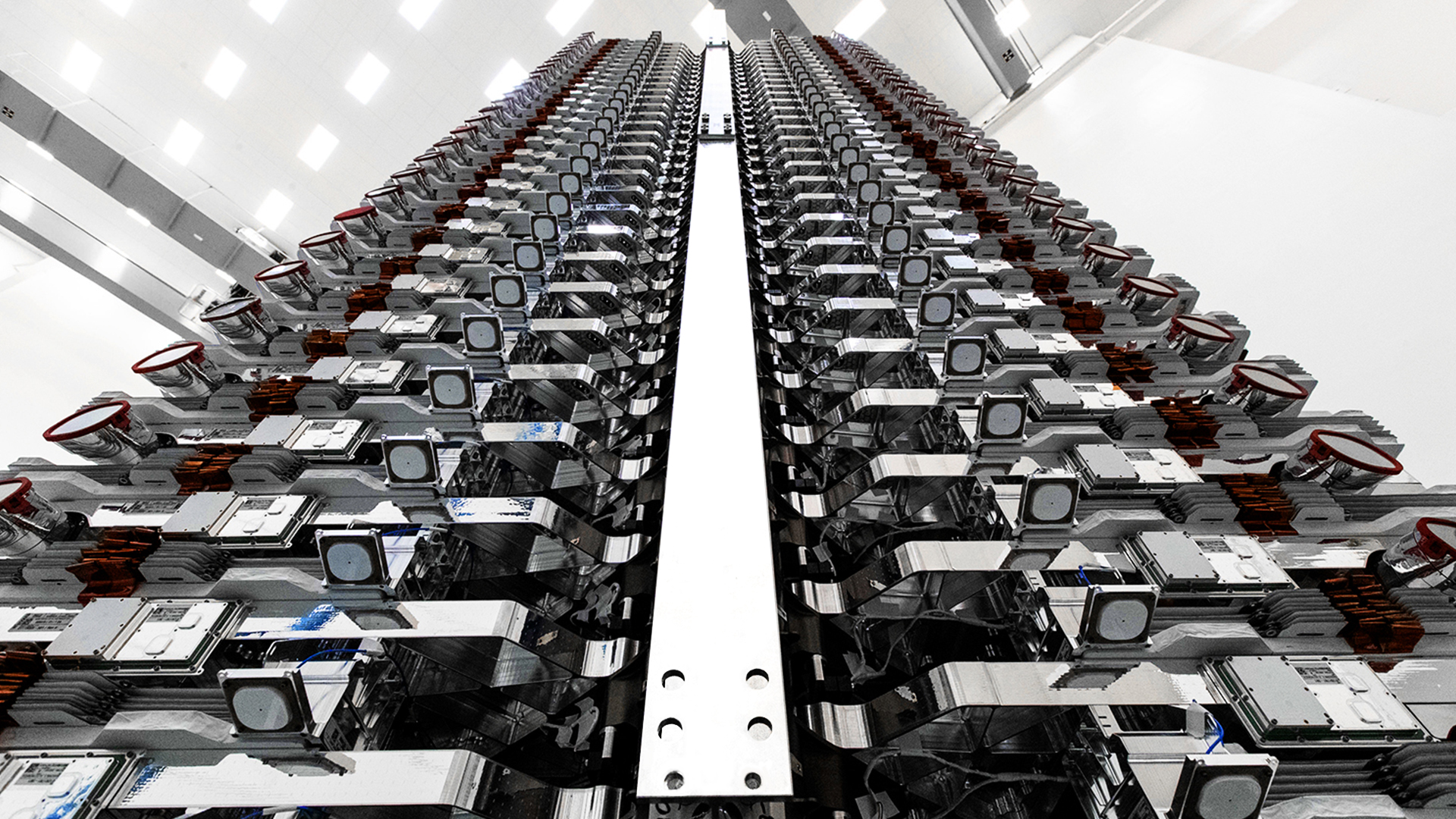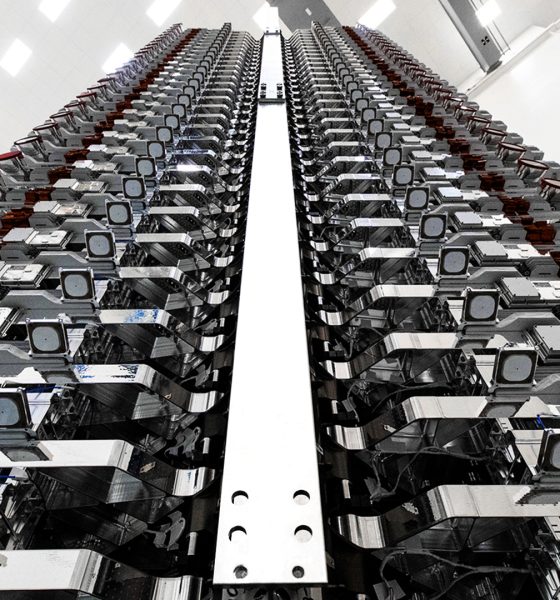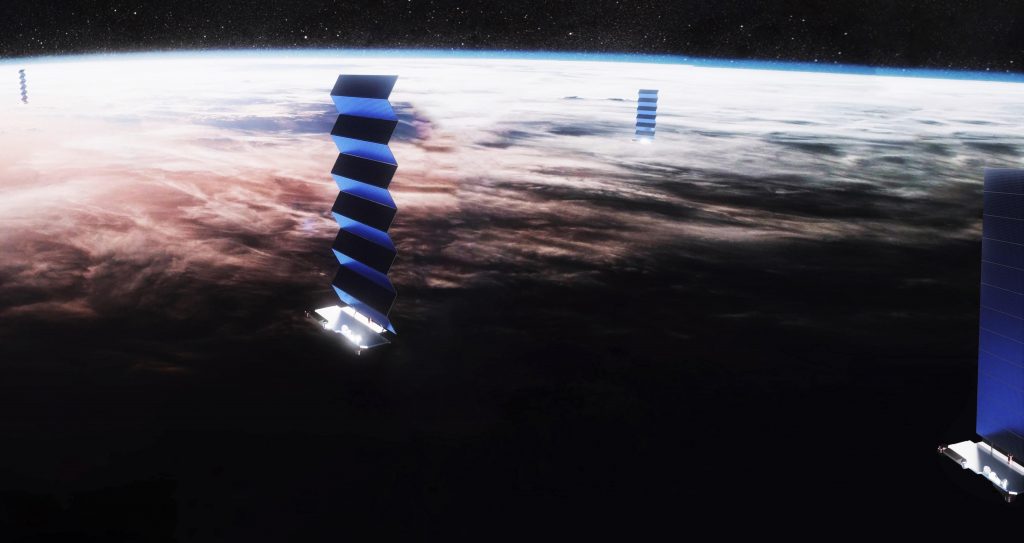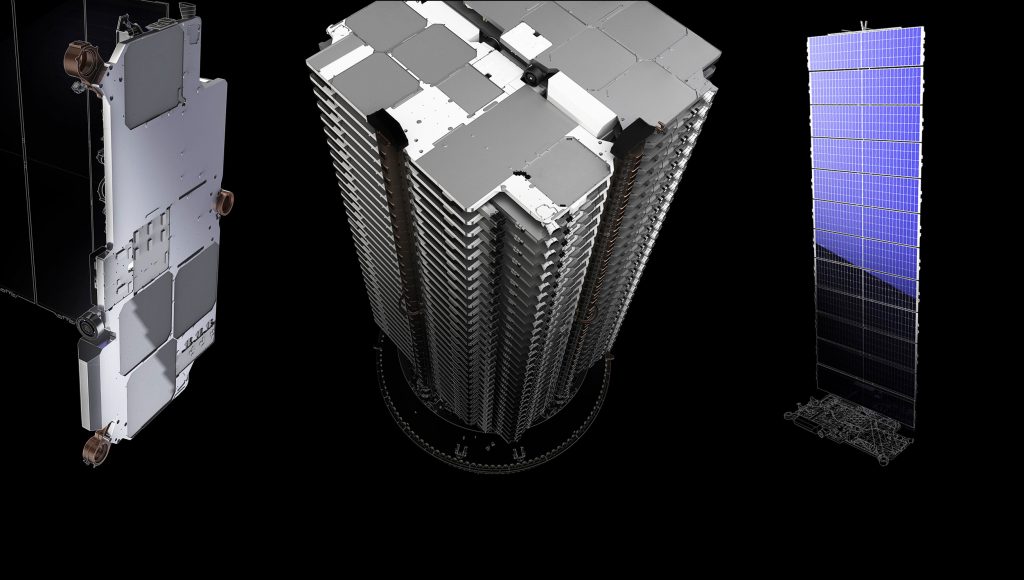

News
SpaceX planning four more Falcon 9-launched Starlink missions this year, permits show
According to a suite of eight FCC Special Temporary Authority licenses SpaceX filed for on August 30th, the company has plans for as many as four additional Starlink satellite launches in 2019, on top of Starlink’s May 23rd launch debut.
Additionally, SpaceX simultaneously requested that the FCC modify its current Starlink application to permit a slight change in orbital characteristics that would drastically improve the broadband satellite constellation’s coverage in its early stages. Combined, SpaceX appears to be extremely confident about the status and near-future progress to be made by its prospective Starlink constellation, confidence presumably inspired by the performance of the first 60 “v0.9” satellites launched three months ago.
Beta-test hiccups
Over the last three months, 50 of the 60 Starlink satellites launched on May 23rd have made their way to their final ~550 km (340 mi) circular orbits. As observed by astronomer Jonathan McDowell and partially confirmed by SpaceX’s own official statements, the company remains in contact with and – more or less – in control of all but three of the 60 Starlink prototypes. SpaceX did confirm in late June that two functioning satellites were being intentionally deorbited to test procedures and performance, while another three satellites had partially failed and were to “passively deorbit”.
And for completeness here is an updated version of the plot showing Starlink satellite height ((p+a)/2) versus time, no recent changes pic.twitter.com/E3a38afRse— Jonathan McDowell (@planet4589) August 28, 2019
Based on the phrasing of SpaceX’s June 28th update, it’s ambiguous if communication and/or control has been completely lost with those three satellites. Additionally, five more satellites have remained paused partway between their ~440 km insertion orbits and ~550 km operational orbits, described two months ago as “going through checkouts prior to completing their orbit raise.” For unknown reasons, that orbit raise never happened. This leaves SpaceX with 57 of 60 satellites that have effectively ‘survived’ and are still under some form of control, while 50 (83%) of the satellites have successfully reached their nominal operational orbits and are performing as intended.
SpaceX continues to waffle between describing these first 60 satellites – internally known as “Starlink v0.9” – as a development test and the first operational Starlink launch. A ~17% failure rate for satellite orbit raising would be unacceptable for a finished product but, on a positive note, is actually quite impressive if one assumes that the 60 spacecraft are high-fidelity prototypes, not operational satellites.

In short, there is a lot of room for improvement – particularly in the realm of short and long-term reliability – but the likely fact that “v0.9” signifies a sort of Starlink beta test means that SpaceX’s next Starlink launches will feature updated and bug-fixed hardware. In the realm of satellites, the practice of flying prototypes as early as possible and risking failures to learn from experience is exceedingly rare, but this behavior is entirely consistent with SpaceX’s preferred approach to rocket and spacecraft development.
300 satellites, 7 months
As mentioned above, SpaceX applied for four FCC STA licenses – effectively communications-related launch permits – on August 30th, all for Starlink missions with nominal No Earlier Than (NET) launch dates in 2019. It must be noted that it’s exceptionally rare for the starting dates of STAs to actually correlate with launch dates, but a best-case scenario typically sees a given launch occur within a handful of weeks of that date. STAs last six months, providing plenty of buffer for all but the most extreme launch delays.
| Mission | Date (NET) |
| Starlink-1 | October 10th |
| Starlink-2 | October 25th |
| Starlink-3 | November 13th |
| Starlink-4 | December 8th |
Of note, NASASpaceflight.com recently published Cape Canaveral Air Force Station (CCAFS) and Kennedy Space Center (KSC) planning dates for SpaceX’s next two Starlink missions, confirming that the company is planning for launches roughly one week after the dates on its newly-requested FCC STAs. Those official planning dates show two back-to-back Starlink launches no earlier than (NET) October 17th and November 4th.

In a best-case scenario where SpaceX successfully manufactures, delivers, and prepares the satellites and readies the Falcon 9 rockets assigned to launch them, the company could complete four more Starlink launches between now and the New Year. Sticking to a three-week cadence hopefully set by Starlink-1 and Starlink-2, two more launches could follow around late-November and mid-December. Of course, as just the first few truly operational launches of more or less finalized “v1.0” Starlink satellites, delays from manufacturing through launch flows are probable and should be expected.
Even completing just one more 60-satellite launch of an updated Starlink design would be an impressive achievement, making SpaceX the first and only entity – country or company – to place more than 100 satellites in orbit in the first year of a satellite system’s launch activities. In a best-case scenario, four additional Starlink launches in 2019 would abruptly take SpaceX from two satellite prototypes to operating almost 300 satellites – unequivocally the largest constellation in the world – in no more than seven months.

Serving customers sooner
According to SpaceX’s Starlink.com website, Starlink will be able to start serving customers at Northern US and southern Canadian latitudes after just six launches (360 satellites), with limited “global coverage of the populated world” available after 24 launches (1440 satellites). However, per an FCC license modification request published on August 30th, the same day as 8 launch STAs, the company believes it can dramatically expedite Starlink coverage (regardless of launch rate) with one relatively simple modification.
This modification would leave inclination (orbit angle relative to Earth’s rotational axis), orbital altitude, and the number of satellites and launches completely unchanged, modifying Starlink’s orbital planes instead. It’s an extreme simplification of the reality of orbital mechanics, but one can imagine orbital planes as roughly akin to lanes on a road. To increase their reach, SpaceX wants to deploy Starlink satellites to three separate planes each launch, ultimately tripling the number of ‘lanes’ (from 24 to 72) while cutting the number of satellites in each ‘lane’ by two-thirds (from 66 to 22). In this analogy, it is logically easier to build fewer ‘lanes’, referring – in this case – to the challenge it poses to the launch vehicle, satellites, or both. SpaceX would only be able to triple Starlink’s orbital ‘lanes’ by requiring the satellites to do the bulk of their own orbit raising, leaning heavily on the performance and reliability of their SpaceX-built electric (ion) propulsion.
According to SpaceX, this could as much as halve the number of launches needed to achieve a given level of Starlink coverage, meaning that SpaceX’s early constellation could reach its initial operational status up to twice as quickly. SpaceX believes that this updated orbital layout of Starlink’s 1584 low Earth orbit (LEO) satellites would also significantly improve coverage and capabilities for areas with high population density (i.e. big cities).
Whether or not the FCC sees fit to rapidly grant SpaceX’s modification request in the next ~8 weeks, SpaceX’s next Starlink launches will be a major step forward for the company’s nascent communications constellation.
Check out Teslarati’s Marketplace! We offer Tesla accessories, including for the Tesla Cybertruck and Tesla Model 3.

News
Tesla FSD fleet is nearing 7 billion total miles, including 2.5 billion city miles
As can be seen on Tesla’s official FSD webpage, vehicles equipped with the system have now navigated over 6.99 billion miles.

Tesla’s Full Self-Driving (Supervised) fleet is closing in on almost 7 billion total miles driven, as per data posted by the company on its official FSD webpage.
These figures hint at the massive scale of data fueling Tesla’s rapid FSD improvements, which have been quite notable as of late.
FSD mileage milestones
As can be seen on Tesla’s official FSD webpage, vehicles equipped with the system have now navigated over 6.99 billion miles. Tesla owner and avid FSD tester Whole Mars Catalog also shared a screenshot indicating that from the nearly 7 billion miles traveled by the FSD fleet, more than 2.5 billion miles were driven inside cities.
City miles are particularly valuable for complex urban scenarios like unprotected turns, pedestrian interactions, and traffic lights. This is also the difference-maker for FSD, as only complex solutions, such as Waymo’s self-driving taxis, operate similarly on inner-city streets. And even then, incidents such as the San Francisco blackouts have proven challenging for sensor-rich vehicles like Waymos.
Tesla’s data edge
Tesla has a number of advantages in the autonomous vehicle sector, one of which is the size of its fleet and the number of vehicles training FSD on real-world roads. Tesla’s nearly 7 billion FSD miles then allow the company to roll out updates that make its vehicles behave like they are being driven by experienced drivers, even if they are operating on their own.
So notable are Tesla’s improvements to FSD that NVIDIA Director of Robotics Jim Fan, after experiencing FSD v14, noted that the system is the first AI that passes what he described as a “Physical Turing Test.”
“Despite knowing exactly how robot learning works, I still find it magical watching the steering wheel turn by itself. First it feels surreal, next it becomes routine. Then, like the smartphone, taking it away actively hurts. This is how humanity gets rewired and glued to god-like technologies,” Fan wrote in a post on X.
News
Tesla starts showing how FSD will change lives in Europe
Local officials tested the system on narrow country roads and were impressed by FSD’s smooth, human-like driving, with some calling the service a game-changer for everyday life in areas that are far from urban centers.

Tesla has launched Europe’s first public shuttle service using Full Self-Driving (Supervised) in the rural Eifelkreis Bitburg-Prüm region of Germany, demonstrating how the technology can restore independence and mobility for people who struggle with limited transport options.
Local officials tested the system on narrow country roads and were impressed by FSD’s smooth, human-like driving, with some calling the service a game-changer for everyday life in areas that are far from urban centers.
Officials see real impact on rural residents
Arzfeld Mayor Johannes Kuhl and District Administrator Andreas Kruppert personally tested the Tesla shuttle service. This allowed them to see just how well FSD navigated winding lanes and rural roads confidently. Kruppert said, “Autonomous driving sounds like science fiction to many, but we simply see here that it works totally well in rural regions too.” Kuhl, for his part, also noted that FSD “feels like a very experienced driver.”
The pilot complements the area’s “Citizen Bus” program, which provides on-demand rides for elderly residents who can no longer drive themselves. Tesla Europe shared a video of a demonstration of the service, highlighting how FSD gives people their freedom back, even in places where public transport is not as prevalent.
What the Ministry for Economic Affairs and Transport says
Rhineland-Palatinate’s Minister Daniela Schmitt supported the project, praising the collaboration that made this “first of its kind in Europe” possible. As per the ministry, the rural rollout for the service shows FSD’s potential beyond major cities, and it delivers tangible benefits like grocery runs, doctor visits, and social connections for isolated residents.
“Reliable and flexible mobility is especially vital in rural areas. With the launch of a shuttle service using self-driving vehicles (FSD supervised) by Tesla in the Eifelkreis Bitburg-Prüm, an innovative pilot project is now getting underway that complements local community bus services. It is the first project of its kind in Europe.
“The result is a real gain for rural mobility: greater accessibility, more flexibility and tangible benefits for everyday life. A strong signal for innovation, cooperation and future-oriented mobility beyond urban centers,” the ministry wrote in a LinkedIn post.
News
Tesla China quietly posts Robotaxi-related job listing
Tesla China is currently seeking a Low Voltage Electrical Engineer to work on circuit board design for the company’s autonomous vehicles.

Tesla has posted a new job listing in Shanghai explicitly tied to its Robotaxi program, fueling speculation that the company is preparing to launch its dedicated autonomous ride-hailing service in China.
As noted in the listing, Tesla China is currently seeking a Low Voltage Electrical Engineer to work on circuit board design for the company’s autonomous vehicles.
Robotaxi-specific role
The listing, which was shared on social media platform X by industry watcher @tslaming, suggested that Tesla China is looking to fill the role urgently. The job listing itself specifically mentions that the person hired for the role will be working on the Low Voltage Hardware team, which would design the circuit boards that would serve as the nervous system of the Robotaxi.
Key tasks for the role, as indicated in the job listing, include collaboration with PCB layout, firmware, mechanical, program management, and validation teams, among other responsibilities. The role is based in Shanghai.
China Robotaxi launch
China represents a massive potential market for robotaxis, with its dense urban centers and supportive policies in select cities. Tesla has limited permission to roll out FSD in the country, though despite this, its vehicles have been hailed as among the best in the market when it comes to autonomous features. So far, at least, it appears that China supports Tesla’s FSD and Robotaxi rollout.
This was hinted at in November, when Tesla brought the Cybercab to the 8th China International Import Expo (CIIE) in Shanghai, marking the first time that the autonomous two-seater was brought to the Asia-Pacific region. The vehicle, despite not having a release date in China, received a significant amount of interest among the event’s attendees.








